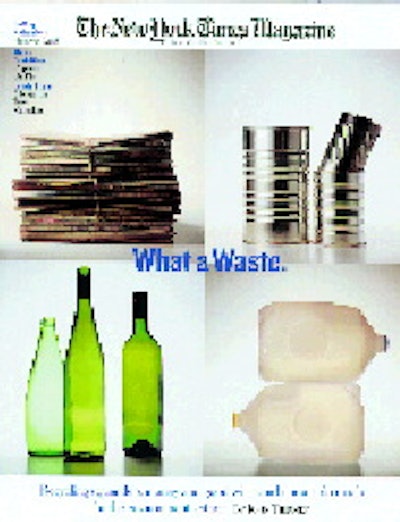That's certainly true for Michele Raymond, editor/publisher of both Recycling Laws International and State Recycling Laws Update. "One industry source told me the article will hurt recycling," Raymond reports. "A negative article in the Wall Street Journal last year did not kill recycling, although it did give those who want to scale back the laws some excuse. But it made others dig their heels in farther to support recycling." The timing of the article might have been politically influenced, Raymond surmises. New York City Mayor Rudolph Guliani mentioned the article when he announced he wanted to amend the city's mandatory 25% recycling ordinance. The city was sued by Natural Resources Defense Council because it did not meet its July 14 deadline. A few observers believe New York will never have an efficient recycling system because of its 80% multi-family dwellings, because unions won't allow new cost-saving technologies, and because there are no "yard clippings" to increase the rate. Referencing another controversial issue, the Editor of Environmental Building News once observed "both sides exaggerate." The "truth" is often somewhere in between. To shed some light in the gap between the "extremes," here is Michele Raymond's analysis of the current recycling situation in the U.S. Is U.S. recycling efficient? Critics, like the New York Times reporter, she says, claim that recycling is a waste of time; we should be spending precious public money on other more urgent needs. They point to fluctuating commodity prices, high costs of curbside collection, poor participation rates in some urban areas, and many misconceptions about the ubiquitous PS foam. The current U.S. approach to recycling is not "efficient," admits Raymond. When the "urge" to recycle was powerful, state lawmakers did not look for the source of waste. They wanted to look good to voters, and nearly all state laws reflected a major concern over residential waste. Several states (New York included) passed source separation mandates that required residents to separate certain items. The emphasis was on trying to pick up recyclables at the curb, making it convenient for those wasteful consumers. "In hindsight, this was a backwards approach," Raymond states. "If you look at where the waste comes from, you see that residential trash is only about one-third of the waste pie. Commercial waste represents about 30% and industrial is the balance. In some cities, commercial waste is 60% of all waste generated. "It doesn't take a mathematician to deduce that it is far more economical to pick up large chunks of recyclables from commercial and industrial customers than to collect small amounts at a time from residents. Moreover, the commercial/industrial stream is more homogenous and less expensive to sort in general." Some laws took the "residential" preference to the extreme, she says. For example, Wisconsin's law requires corporations to fund a $40 million/year system that subsidizes 1겨 cities and towns to do their own thing. Businesses are required to recycle because of the landfill bans, but they are not allowed to use state-financed material recovery facilities! Industrial waste was ignored altogether in the laws. Another mistake was trying to tell people exactly what to recycle. This has resulted in a set of "traditional" materials being picked up, ignoring local economics. If there is no market for green glass in a state, Raymond poses, why require cities to pick it up? Mandates without flexibility put cities in a poor position. In some areas, it may make sense to only pick up aluminum and plastics, but have you ever heard of that? The ideal world If indeed collection economics mattered--and politics didn't matter--here is what Raymond says the hierarchy might look like: * Mandate or provide strong incentives for all industrial solid waste to be recovered when feasible; avoid use of public landfill facilities. * Encourage markets for the materials. Provide government assistance for very small companies. * Mandate or provide strong incentives for commercial businesses of all sizes to recycle their three largest items. Either provide government collection, or require haulers to pick up recyclables from small businesses without price discrimination. * Once the infrastructure is improved, then mandate recycling in multi-family dwellings, and require space or technology for source separation in new commercial and multi-family buildings. * Once that infrastructure is moving, then provide a dense network of drop-off points for residential areas. Educate consumers. Experiment with incentives to recycle without forcing consumers to drive their gas-eating cars long distances. Institute pay-per-can (volume-based fees) when feasible. * Then, finally, set up curbside collection in dense single family areas, phasing in materials as markets develop. But in the real world, it's too late. Curbside recycling is here. About all industry can do is try to suggest improvements for efficiency. It's too late to point to critics to justify retreating from current or planned recycling investments. Large consumer product companies run nearly the same risk that politicians do when it comes to the "environmental record." But, Raymond explains, you can't have it both ways: if your organization promotes curbside because it is politically expedient, be prepared to take the heat when the economics of curbside come under fire. Long-term, Raymond believes history will show that the recycling advocates were right, even if governments went after collection inefficiently. It only takes one factor--high energy prices; high landfill tipping fees; certain material shortages--to change the recycling picture dramatically. Are laws needed? The critics seem to imply that recycling laws are somehow not necessary--they "interfere' with the "free" market. Raymond emphatically disagrees. The way government has set up programs and laws, the recycling system is not "free market" at all, but government services oriented. It is doubtful America would have moved from 10% recycling in 1989 to 25% today without some of those laws, imperfect as they are. For example, it is doubtful paper companies could have gotten billions in financing for de-inking mills if there were no recycled content mandates. Unfortunately, consumers only change their habits because of economic incentives or because of crises. The garbage barge was a "fake" crisis that encouraged states to take action for a future resource situation. Consumers have not demanded recycled content in packaging and products; this is proven by actual purchases, notes Raymond. That is why the "green marketing" trend faded quickly--not enough "green" money in it for the mainstream companies. In the future, companies that have planned for high prices of materials with replacements will be in a better position to maintain their market position. c


























